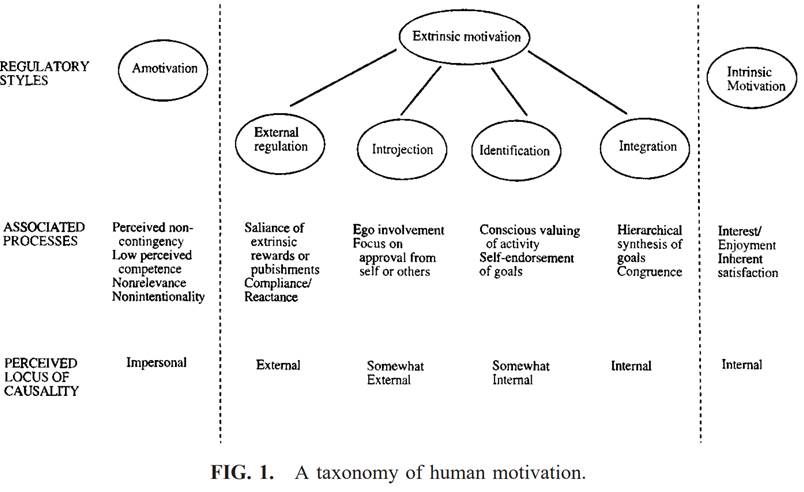There’s no doubt that motivation is required to achieve a goal, but the question lies in whether intrinsic or extrinsic motivation is at play. Intrinsic motivation is fueled by the internal satisfaction that comes with completing an action, even if there is no obvious reward. Extrinsic motivation, meanwhile, is driven by the promise of an external reward — or the avoidance of a punishment — rather than the pursuit of personal satisfaction.
Intrinsic vs. Extrinsic Motivation
As a result, intrinsic motivation is commonly found in situations where a goal or action has deep meaning, like volunteering for a nonprofit because it brings personal fulfillment or taking up an art project because it makes you happy. Extrinsic motivation tends to show up in scenarios where someone is after an external reward, like exceeding a work quota to earn a raise or competing in a tournament for a prize.
Both intrinsic and extrinsic motivators are critical to success. “A good balance of both intrinsic and extrinsic motivators at work is ideal,” said Fran Maxwell, leader of the people advisory and organizational change proactive at business consultancy Protiviti.

What Is Intrinsic Motivation?
Intrinsic motivation stems from internal factors or forces. For instance, completing a task because it’s personally fulfilling; the satisfaction of setting and reaching long- or short-term goals; excelling as a point of pride; and earning more money for the feeling of satisfaction in providing for one’s family.
Intrinsic motivation can guide corporate HR efforts. Take the current trend toward enabling employees to live their purpose. Perks such as volunteer days or participating in corporate philanthropy help employees live their purpose, or, in other words, use work to satisfy internal needs and longings in addition to earning a living.
“There’s been a shift towards not wanting work to be everything,” said Jordan Nielsen, assistant professor of management at Purdue University. “It seems like a step back where people are saying, ‘even if this work is really meaningful, I want to have a life outside of work.’”
What Is Extrinsic Motivation?
Extrinsic motivation comes from external factors. Hope of a reward (the proverbial carrot) or fear of punishment (the proverbial stick) are both extrinsic motivators. Nielsen defines extrinsic motivation as a means to an end. “Money and status are the first two things that usually pop into people’s heads,” he said.
Salespeople, for example, generally thrive on external motivators such as bonuses, which is why organizations often hold sales contests to motivate them.
Intrinsic or Extrinsic Motivation: Which Is Best?
Which motivator is more powerful depends on the situation, Maxwell said. Intrinsic motivators can be more sustainable, as they tend to spring from someone’s personality or moral compass, “but I do think it depends on the personality type,” he added.
The key is to make sure these types of motivation are used to complement — not interfere with — one another. For example, an external reward can encourage someone to try an activity they weren’t interested in at first or learn a new skill. It can also serve as a standard to help someone gauge their performance. But applying an external reward to an activity someone already inherently enjoys might lessen the satisfaction they get from that activity.
So, organizations should identify each individual’s motivators and nurture them by asking or through personality assessments.
“Adjusting to motivators is key to help assist in the overall productivity of the team,” Maxwell said.
Motivation on a Continuum
Human emotions and motivators are complex, so much so that psychologists Richard Ryan and Edward Deci put them on a continuum.
The continuum that illustrates their Self Determination Theory of Motivation begins on one end with amotivation, or a lack of motivation, and ends on the other with intrinsic motivation, which Ryan and Deci label as “interest, enjoyment and/or inherent satisfaction.”
In between are four gradations of extrinsic motivation, ranging from performing a task out of fear or punishment or hope of reward (external regulation) to performing a task because it aligns with one’s needs or values.
Prosocial motivation is another variant that has powerful potential, and that can take on both intrinsic and extrinsic forms. Prosocial means the care and concern for the well-being of others and can stem from either external or internal factors, Nielsen said. Being coerced to volunteer (extrinsic) can create internal conflict and uncomfortableness. Charitable work done voluntarily (intrinsic), on the other hand, satisfies an internal need.
How Companies Motivate Employees
Paychecks, benefits, perks: The effort to motivate people permeates nearly every aspect of human resources efforts. And no wonder. “Motivation produces,” write Ryan and Deci. Here are ways companies strive to motivate employees.
More Money
A steady income is necessary for securing both living essentials and additional wants. External incentives like raises and promotions, then, are a great way to keep employees motivated.
“Money is always going to matter, because [employees] need resources to do stuff,” Nielsen said.
Appealing Company Culture
A healthy corporate culture can stimulate intrinsic motivation. “You have people who are able to do their work because they care about the work itself,” Nielsen said. “That intrinsic motivator is going to often be the difference between a company that’s really innovating and doing cool stuff and one that isn’t.”
Workplace Perks
Dog-friendly offices, ping-pong tables, and free food “seemed like a great idea 10 years ago, and that stuff does seem nice,” Nielsen said. Even so, he’s seen no evidence that trendy workplace perks keep people at an organization.
“People care much more about stuff that really matters,” he added, “like the work itself and whether they can express their values through work.”
Individualized Motivation
Identifying and nurturing motivation is “imperative,” said Leslie Mizerak, a coach with edtech company Nimblywise. “That’s where we get the best performance, the highest level or results, buy-in loyalty and the highest level of engagement — all those amazing words come from good motivation.” It’s why managers ask about goals at one-on-ones and annual performance reviews.
Motivating each and every employee can be tricky, as many factors, including rewards, personal goals and enjoyment, and personality combine to motivate individuals, said Dan Moshavi, dean of the Lucas College and Graduate School of Business at San Jose State University.
“One of the challenges organizations face is that individuals are motivated in different ways by different things, so it’s tough to create a ‘one size fits all’ set of incentives, although they try,” Moshavi added. “Listening, experimenting and observing are key.”
Whether intrinsic or extrinsic motivators are more effective depends on the individual employee. Bonuses can positively affect short-term productivity, while making sure someone’s work aligns with their interest can spark greater engagement and company loyalty, Moshavi said. What HR professionals refer to as “person-job fit,” meaning the alignment of one’s skills with the required tasks, can also strongly motivate or, in the case of a poor fit, demotivate, Moshavi said.
Another challenge is that motivations change over time. Early in Moshavi’s career, teacher ratings, awards, peer reviews and other external factors were highly motivating. Later in his career, he pivoted to administration as his needs became more intrinsic.
“I get great satisfaction from recognizing, rewarding and praising others,” Moshavi said. “But that’s me — I know folks who become more extrinsically motivated over time, constantly striving for the next promotion.”
How to Identify Your Motivators
Even if employees work at a company that excels at motivation, they must identify and nurture motivation on their own to create successful and satisfying careers. Paying attention to other’s observations, examining goals and past motivators are some of the ways to figure out what drives you.
Intrinsic and Extrinsic Motivations
Intrinsic: Enjoyable, satisfying, fulfilling, fun, interesting
Extrinsic: Payment, fear of punishment, hope of reward, social acceptance
Observations
Katie Long enjoyed playing sports as a child; her mother often commented on how the prospect of a win motivated Long. And throughout her life, Long enjoyed setting and reaching goals. “It was pretty motivating for me to see if I could do it,” she said.
Right out of college, Long worked for a media company. She liked the work but wasn’t sure it was her life’s calling. As she worked in media, taking advantage of the opportunity to learn the business, she was introduced to the world of sales. Bingo: The competitive nature of sales struck a motivational chord, as did the chance to earn more money. “Previous managers pointed out that I was definitely motivated to earn more in terms of compensation,” said Long, head of sales at Beachfront, a convergent TV ad platform.
Now, as a manager, Long tries to spot and nurture motivators for her eight team members. “There’s always going to be tasks they have to accomplish as part of their role,” she said. “But I think it’s my job to align opportunities with those individuals because that’s where you see really great success.”
Past Motivators
Feeling a little lackluster in your current role? Think back to situations or projects that ignited your passions in the past, Mizerak said.
Here’s another reason to consider past motivations: Motivators change over time and over the span of a career. Money, status and a clear career path might have motivated you as a college graduate; decades later, your desire to mentor might be more motivating.
“Originally, it was about my own personal growth and learning new things,” said Mizerak of her own career. “Now I get much more joy from helping other people grow and develop.”
Goals
“Where do you see yourself in five years?” is a time-honored interview and performance review question that gets to the heart of intrinsic motivation. “It tells me what you’re looking for,” said Mizerak. The answer provides the opportunity to dig deeper. For instance, do you see yourself as a manager one day? You might be acting out of either extrinsic (more pay, higher status in the company) or intrinsic (the desire to support a team) motivators.
On the flip side, thinking about why you don’t meet some goals can help determine your motivators, said Cory Althoff, senior vice president of coding systems at CompTIA. If you’re missing deadlines on projects that really don’t float your boat, perhaps the intrinsic motivator is missing and it’s time to ask your manager for an external motivator. Or if you’re working just for the paycheck, and your dream is to save the world, it might be time to consider a new job at a nonprofit.
“Think about what your actual goal is and if it aligns with what motivates you,” Althoff said.
Another goal-aligned tactic: Consider what you do when you set a goal. Do you keep it to yourself or share it with the world in hopes that the world will hold you accountable? The first approach is intrinsic, the second, extrinsic.
Hobbies and Pastimes
What you do off the clock can help you determine what motivates you, Althoff said. Gamers, for instance, might be intrinsically motivated by the desire to win and the thrill of meeting challenges; tech employees who moonlight might be extrinsically motivated to earn more money and/or intrinsically motivated to work on projects more interesting than what the day gig offers.
“Ask yourself what you do for fun and why,” Althoff said.
Whatever motivators you land on, they are almost guaranteed to act as a key that unlocks career potential.
Frequently Asked Questions
What is the difference between intrinsic and extrinsic motivation?
Intrinsic motivation is fueled by internal factors, such as a desire to achieve a certain goal and finding joy in the pursuit of excellence. Meanwhile, extrinsic motivation is driven by external factors, such as monetary rewards and company quotas.
What are examples of intrinsic and extrinsic motivation?
Examples of intrinsic motivation include wanting to achieve self-sufficiency and feeling satisfied when one is able to provide for their family. Examples of extrinsic motivation include sales quotas and the promise of financial rewards.




